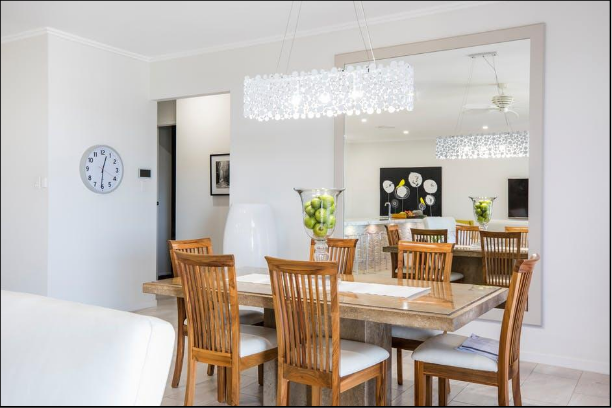Wall-mounted mirrors have become a staple in home decor. Their journey from simple, functional objects to stylish statements is fascinating.
In this blog post, we’ll take you through history. You’ll learn how mirrors evolved. We’ll also explore their growing role in our homes today.
Early Beginnings of Wall-Mounted Mirrors
The story of mirrors begins in ancient times. The first mirrors were not wall-mounted. Early civilizations, such as the Egyptians and Greeks, used polished metal surfaces. These gave a reflection but were not very clear.
They were often small and handheld. Around 600 AD, craftsmen in China and India began to create more advanced mirrors. These were made from polished bronze.
The Middle Ages: A Fusion of Art and Function
By the Middle Ages, mirrors became more common in Europe. Glassmaking techniques were improving. Artisans began to create mirrors using glass with a metallic backing.
These mirrors were often framed in wood or metal. They served both practical and decorative purposes. In homes and public buildings, wall-mounted mirrors started to appear. They were still rare and very expensive.
The Renaissance: Mirrors as Status Symbols
During the Renaissance, mirrors became symbols of wealth and status. The art and science of making mirrors saw major advancements. The invention of the cristallo glass in Italy allowed for clearer mirrors.
Venice became a hub for mirror production. Venetian mirrors were highly sought after. They often featured ornate frames and were used to decorate the homes of the wealthy. This period marked the beginning of mirrors being seen as luxury items.
The Baroque and Rococo Eras: Mirrors as Design Elements
The 17th and 18th centuries saw an explosion in the use of mirrors. The Baroque and Rococo eras emphasized grandeur and opulence. Mirrors became essential in interior design.
Large wall-mounted mirrors were used to enhance space and light. They often featured intricate, gilded frames. Mirrors were placed in grand halls, salons, and ballrooms. They played a key role in creating the impression of wealth and luxury.
The Industrial Revolution: Making Mirrors Accessible
The Industrial Revolution brought about significant changes. The process of creating mirrors became more efficient and less expensive. Mass production made mirrors more accessible to the middle class.
Wall-mounted mirrors became a common feature in homes. They were no longer just luxury items. Mirrors were used in hallways, living rooms, and bedrooms for both practical and decorative purposes.
The 20th Century: Mirrors in Modern Design
The 20th century saw a shift in design philosophies. Movements like Art Deco and Modernism emphasized clean lines and minimalism. Mirrors continued to play a key role in home decor.
Wall-mounted mirrors became sleeker and more streamlined. They were not just functional but also pivotal in creating modern interiors.
Contemporary Trends: Mirrors as Art
Today, wall-mounted mirrors are more than just reflective surfaces. They are considered works of art. Designers experiment with shapes, sizes, and frames.
From geometric patterns to bold colors, mirrors are used to make design statements. They can be focal points in a room or blend seamlessly with other design elements.
Mirrors also have practical benefits. They make spaces look larger and brighter. In small apartments or homes, mirrors are invaluable.
The Role of Technology
Advancements in technology continue to shape the evolution of mirrors. Smart mirrors are a recent innovation. They come with built-in lighting, touch screens, and internet connectivity. These mirrors are used in bathrooms, wardrobes, and even offices.
They provide information such as weather updates, news, and communication features. Technology is making mirrors more interactive and versatile.
Sustainability and Materials
Sustainability has become a crucial factor in design. Many mirrors today are made using eco-friendly materials. Recycled glass and sustainable timber are popular choices.
There is also a focus on ethical manufacturing processes. Consumers are more aware of the environmental impact and are making informed choices. This trend is influencing the design and production of wall-mounted mirrors.
Customization and Personal Expression
Personalization is a significant trend in modern decor. People want their spaces to reflect their personality. Custom mirrors allow for this personal touch.
You can choose the shape, size, and frame to suit your style. Whether you prefer a vintage look or a contemporary design, there’s a mirror out there for you.
The Psychological Impact of Mirrors
Mirrors also have a psychological impact. They can boost self-awareness and confidence. A well-placed mirror can enhance the mood of a room. In spaces where natural light is limited, mirrors help by reflecting light and making the area feel more open. They create a sense of depth and dimension, adding to the overall ambiance.
In retail stores, they can create an illusion of more merchandise and encourage customers to make purchases. In restaurants, mirrors can enhance the dining experience by creating a sense of intimacy and making the space feel larger. In the gym, mirrors are commonly used to help people correct their form and track progress. Find out more tips when buying wall mirrors here.
The Future of Wall-Mounted Mirrors: What’s Next?
As we stand on the brink of new technological and aesthetic horizons, the role of wall-mounted mirrors is poised to evolve even further. Cutting-edge innovations and changing design ideas will transform how we use and see mirrors.
Augmented and Virtual Reality Integration
Imagine a mirror that can not only reflect your image but also overlay digital information or virtual avatars in real time. These smart mirrors can be used in various applications, such as:
- virtual dressing rooms
- interactive fitness trainers
- personalized beauty and makeup tutorials
- interior design visualization
Advanced Materials and Nanotechnology
Material science is also likely to play a significant role in the future of wall-mounted mirrors. Innovations in nanotechnology could lead to the development of ultra-thin, flexible mirrors. It can be mounted on curved surfaces or even rolled up for portability.
Advanced materials could also make mirrors more durable and resistant to the following:
- scratches
- moisture
- other environmental factors
Self-cleaning surfaces could further enhance the functionality and longevity of mirrors. This makes them easier to maintain and more hygienic.
Reflecting Your Style From Function to Fashion
Wall-mounted mirrors have come a long way from their ancient origins. What began as a functional item has evolved into a fashion statement. Mirrors have been integral to art, culture, and interior design.
Today, they are more accessible and varied than ever. They reflect our personal styles and enhance our living spaces. As technology and sustainability continue to influence design, the future of mirrors looks bright.
For similar topics, visit the rest of our blog!
Stay in touch to get more updates & news on Tribunebreaking!







